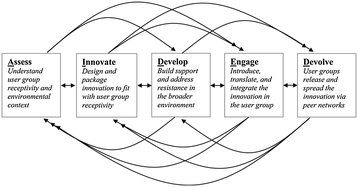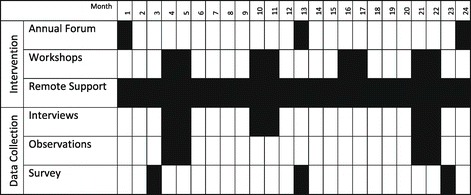Organizational culture change in U.S. hospitals: a mixed methods longitudinal intervention study
- PMID: 25889753
- PMCID: PMC4356105
- DOI: 10.1186/s13012-015-0218-0
Organizational culture change in U.S. hospitals: a mixed methods longitudinal intervention study
Abstract
Background: Improving outcomes for patients with acute myocardial infarction (AMI) is a priority for hospital leadership, clinicians, and policymakers. Evidence suggests links between hospital organizational culture and hospital performance; however, few studies have attempted to shift organizational culture in order to improve performance, fewer have focused on patient outcomes, and none have addressed mortality for patients with AMI. We sought to address this gap through a novel longitudinal intervention study, Leadership Saves Lives (LSL).
Methods: This manuscript describes the methodology of LSL, a 2-year intervention study using a concurrent mixed methods design, guided by open systems theory and the Assess, Innovate, Develop, Engage, Devolve (AIDED) model of diffusion, implemented in 10 U.S. hospitals and their peer hospital networks. The intervention has three primary components: 1) annual convenings of the ten intervention hospitals; 2) semiannual workshops with guiding coalitions at each hospital; and 3) continuous remote support across all intervention hospitals through a web-based platform. Primary outcomes include 1) shifts in key dimensions of hospital organizational culture associated with lower mortality rates for patients with AMI; 2) use of targeted evidence-based practices associated with lower mortality rates for patients with AMI; and 3) in-hospital AMI mortality. Quantitative data include annual surveys of guiding coalition members in the intervention hospitals and peer network hospitals. Qualitative data include in-person, in-depth interviews with all guiding coalition members and selective observations of key interactions in care for patients with AMI, collected at three time points. Data integration will identify patterns and major themes in change processes across all intervention hospitals over time.
Conclusions: LSL is novel in its use of a longitudinal mixed methods approach in a diverse sample of hospitals, its focus on objective outcome measures of mortality, and its examination of changes not only in the intervention hospitals but also in their peer hospital networks over time. This paper adds to the methodological literature for the study of complex interventions to promote hospital organizational culture change.
Figures
Similar articles
-
How guiding coalitions promote positive culture change in hospitals: a longitudinal mixed methods interventional study.BMJ Qual Saf. 2018 Mar;27(3):218-225. doi: 10.1136/bmjqs-2017-006574. Epub 2017 Nov 3. BMJ Qual Saf. 2018. PMID: 29101290 Free PMC article.
-
Changing hospital organisational culture for improved patient outcomes: developing and implementing the leadership saves lives intervention.BMJ Qual Saf. 2021 Jun;30(6):475-483. doi: 10.1136/bmjqs-2019-010734. Epub 2020 Jul 16. BMJ Qual Saf. 2021. PMID: 32675328 Free PMC article.
-
Strategies to reduce hospital 30-day risk-standardized mortality rates for patients with acute myocardial infarction: a cross-sectional and longitudinal survey.BMC Cardiovasc Disord. 2014 Sep 24;14:126. doi: 10.1186/1471-2261-14-126. BMC Cardiovasc Disord. 2014. PMID: 25252826 Free PMC article.
-
Making quality improvement stick and stay: Two lines of insurance.Healthc Manage Forum. 2016 Jan;29(1):28-32. doi: 10.1177/0840470415616318. Epub 2015 Dec 8. Healthc Manage Forum. 2016. PMID: 26656388 Review.
-
Innovation in hospitals: a survey of the literature.Eur J Health Econ. 2007 Sep;8(3):181-93. doi: 10.1007/s10198-006-0016-3. Epub 2006 Dec 21. Eur J Health Econ. 2007. PMID: 17186204 Review.
Cited by
-
Life Expectancy after Myocardial Infarction, According to Hospital Performance.N Engl J Med. 2016 Oct 6;375(14):1332-1342. doi: 10.1056/NEJMoa1513223. N Engl J Med. 2016. PMID: 27705249 Free PMC article.
-
Using wearable devices to generate real-world, individual-level data in rural, low-resource contexts in Burkina Faso, Africa: A case study.Front Public Health. 2022 Sep 30;10:972177. doi: 10.3389/fpubh.2022.972177. eCollection 2022. Front Public Health. 2022. PMID: 36249225 Free PMC article.
-
A Board Level Intervention to Develop Organisation-Wide Quality Improvement Strategies: Cost-Consequences Analysis in 15 Healthcare Organisations.Int J Health Policy Manag. 2022 Feb 1;11(2):173-182. doi: 10.34172/ijhpm.2020.91. Int J Health Policy Manag. 2022. PMID: 32610820 Free PMC article.
-
Identifying and addressing gaps in the implementation of a community care team for care of Patients with multiple chronic conditions.BMC Health Serv Res. 2019 Nov 15;19(1):843. doi: 10.1186/s12913-019-4709-6. BMC Health Serv Res. 2019. PMID: 31730457 Free PMC article.
-
Association Between Hospital Safety Culture and Surgical Outcomes in a Statewide Surgical Quality Improvement Collaborative.J Am Coll Surg. 2019 Aug;229(2):175-183. doi: 10.1016/j.jamcollsurg.2019.02.046. Epub 2019 Mar 9. J Am Coll Surg. 2019. PMID: 30862538 Free PMC article.
References
-
- Centers for Medicare & Medicaid Services . Medicare hospital quality chartbook. Baltimore: Centers for Medicare & Medicaid Services; 2013.
Publication types
MeSH terms
Grants and funding
LinkOut - more resources
Full Text Sources
Other Literature Sources
Medical
Miscellaneous




